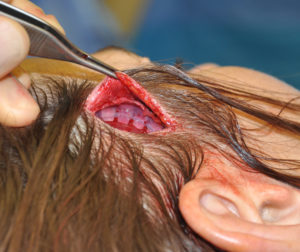Augmentation of the temporal region of the face has become popularized through the use of injectable synthetic fillers and fat. While such injectable treatments can be successful, they can be plagued by unpredictability of volume retention and the need for ongoing treatments.
Like it is anywhere else on the face where aesthetic bone augmentation is desired, implants offer a permanent solution to the volume retention issue as well as that of the smoothness of the augmented contours. But the temporal region is not a bony support region and has historically not been treated by implant augmentation methods.
Temporal implants are the newest type of facial implants and have been successful for several different reasons. One reason has been the low durometer of the silicone used in temporal implants. This makes them feel more like muscle than bone which is important in a soft tissue region of the temples. That physical feature also makes them able to be inserted through incisions that are smaller than the diameter measurements of the implant.

Temporal implants are unique amongst facial implants since this is not a bone augmentation site. This is a muscle augmentation site since muscle is what principally comprises the temporal fossa. The feel of the implant and its location should reflect what it is intended to augment.
Dr. Barry Eppley
Indianapolis, Indiana


